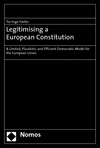Legitimising a European Constitution
A Limited, Pluralistic and Efficient Democratic Model for the European Union
Abstract
The discontent with the European Union expressed in the referenda over the Maastricht Treaty in the beginning of the 1990s and more recently enunciated through the French and Dutch rejection of the European Constitutional Treaty has widely been perceived as being a consequence of the Union"s legitimacy deficit. There might be different reasons for this deficit. Whereas some argue that it is rooted in a lack of Humean legitimacy, i.e. a lack of utilitarian problem-solving capacity (output legitimacy), others hold that it is a consequence of the lack of Lockean legitimacy or popular consent or approval of the Union, i.e. a lack of democratic legitimacy (input legitimacy). It is the aim of this book to introduce a democratic model that bridges these two sources of legitimacy and which, bearing in mind the unique institutional, legal and societal qualities of the European Union, could provide a solid basis of legitimacy of the European Union in general and the European Constitutional Treaty in particular.
Dr. Tor-Inge Harbo holds a Norwegian law degree and a MA in European Studies. His PhD thesis was written under the supervision of Professor Dr. iur. Ulrich K. Preuss at the Free University of Berlin, Otto Suhr Institute of Political Studies, Department Legal Bases of Politics. He is currently working as a lecturer and researcher at the Faculty of Law, University of Oslo.
- 15–20 Introduction 15–20
- 21–100 Part I - Dimensions 21–100
- 21–25 Introduction 21–25
- 50–52 Conclusion 50–52
- 52–53 Introduction 52–53
- 75–77 Conclusion 75–77
- 77–78 Introduction 77–78
- 98–100 Conclusion 98–100
- 101–192 Part II - Frames 101–192
- 101–104 Introduction 101–104
- 128–130 Conclusion 128–130
- 130–131 Introduction 130–131
- 134–150 5.2. Constitution 134–150
- 164–166 Conclusion 164–166
- 166–167 Introduction 166–167
- 181–190 6.2. A European demos? 181–190
- 190–192 Conclusion 190–192
- 193–196 Introduction 193–196
- 221–222 Conclusion 221–222
- 222–223 Introduction 222–223
- 243–246 8.3. Direct democracy 243–246
- 246–247 Conclusion 246–247
- 247–248 Introduction 247–248
- 269–270 Conclusion 269–270
- 271–275 Conclusions 271–275
- 276–290 Reference List 276–290

